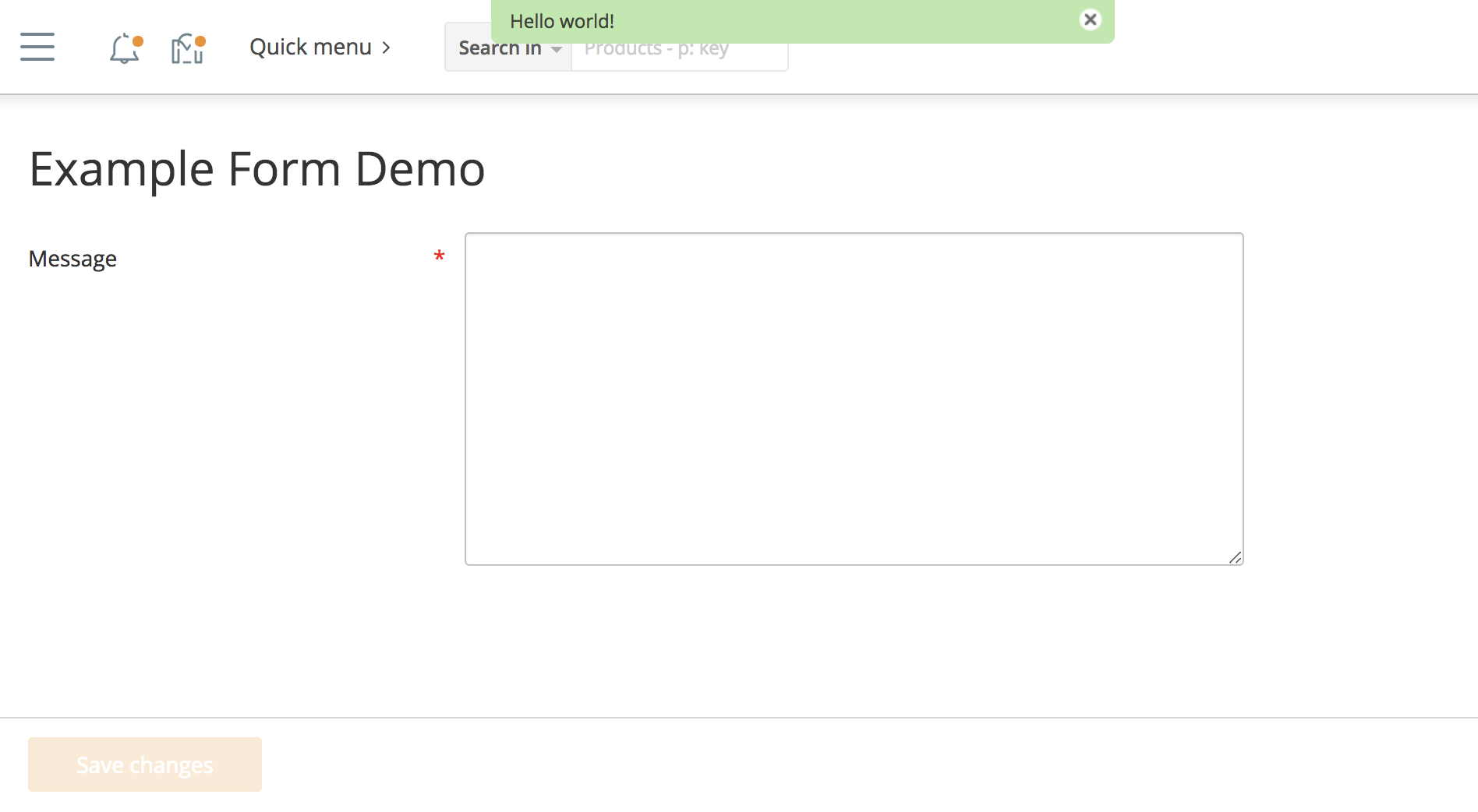Introduction
This article illustrates how you can add forms to X-Cart page: a form where user can specify some information and submit it to the store. Then, X-Cart will run controller of the page and do something with this information.
For the sake of example, we will create a module that will add a form with one field. When this form is submitted, the message from the field will be displayed in top message.
Preparation: creating module and page
We start off with creating a module with developer ID XCExample and module ID FormDemo. Then, we create page admin.php?target=example_form_demo. For that we create:
Controller class
\XLite\Module\XCExample\FormDemo\Controller\Admin\ExampleFormDemowith the following content:<?php
namespace XLite\Module\XCExample\FormDemo\Controller\Admin;
/**
* ExampleFormDemo
*/
class ExampleFormDemo extends \XLite\Controller\Admin\AAdmin
{
}Page viewer class
\XLite\Module\XCExample\FormDemo\View\Page\Admin\ExampleFormDemowith the following content:<?php
namespace XLite\Module\XCExample\FormDemo\View\Page\Admin;
/**
* ExampleFormDemoPage
*
* @ListChild (list="admin.center", zone="admin")
*/
class ExampleFormDemo extends \XLite\View\AView
{
/**
* Return list of allowed targets
*/
public static function getAllowedTargets()
{
return array_merge(parent::getAllowedTargets(), array('example_form_demo'));
}
/**
* Return widget default template
*/
public function getDefaultTemplate()
{
return 'modules/XCExample/FormDemo/page/example_form_demo/body.twig';
}
}Empty page template
skins/admin/modules/XCExample/FormDemo/page/example_form_demo/body.twig.
Creating form
To create form widget, we create \XLite\Module\XCExample\FormDemo\View\Model\FormDemo class with the following content:
<?php
namespace XLite\Module\XCExample\FormDemo\View\Model;
class FormDemo extends \XLite\View\Model\AModel
{
protected $schemaDefault = [
'message' => [
self::SCHEMA_CLASS => 'XLite\View\FormField\Textarea\Simple',
self::SCHEMA_LABEL => 'Message',
self::SCHEMA_REQUIRED => true,
],
];
protected function getDefaultModelObject()
{
return null;
}
protected function getFormClass()
{
return 'XLite\Module\XCExample\FormDemo\View\Form\FormDemo';
}
}
This class is very similar to one we create for entity editing form.
Our class extends
\XLite\View\Model\AModelclass and we have to implement two required methodsgetDefaultModelObject()andgetFormClass()in it:class FormDemo extends \XLite\View\Model\AModelWe list fields to be displayed in
$schemaDefaultvariable.protected $schemaDefault = [
'message' => [
self::SCHEMA_CLASS => 'XLite\View\FormField\Textarea\Simple',
self::SCHEMA_LABEL => 'Message',
self::SCHEMA_REQUIRED => true,
],
];'message' is the name of the field and once we submit the form, we can access value of this field as
\XLite\Core\Request::getInstance()->message;self::SCHEMA_CLASSparameter defines what form field class will be used for displaying this field;self::SCHEMA_LABELparameter defines what label will be next to the field;self::SCHEMA_REQUIREDboolean flag defines whether this field must be filled in or it is optional.getDefaultModelObject()method usually defines what object we are currently editing. But since we are not going to edit any object, but merely submit a request, this method returnsnull.getFormClass()method returns a class that defines<form>tag, our form will be wrapped into. We need to create this class as it does not exist yet, so we create\XLite\Module\XCExample\FormDemo\View\Form\FormDemoclass with the following content:<?php
namespace XLite\Module\XCExample\FormDemo\View\Form;
class FormDemo extends \XLite\View\Form\AForm
{
protected function getDefaultTarget()
{
return 'example_form_demo';
}
protected function getDefaultAction()
{
return 'send';
}
}Such implementation means that our
<form>tag will have following fields:<input type="hidden" name="target" value="example_form_demo">
<input type="hidden" name="action" value="send">and they will submit a form to
admin.php?target=example_form_demoURL with 'action' parameter as 'send'.
That is it with the form widget. Now, we should add it to the page, so we edit the skins/admin/modules/XCExample/FormDemo/page/example_form_demo/body.twig template and put the following code there:
{{ widget('\\XLite\\Module\\XCExample\\FormDemo\\View\\Model\\FormDemo') }}
If you open admin.php?target=example_form_demo page, you will see the form that can be submitted, but X-Cart will not handle such request at all. The next step is to add a handler of such request.
If you create a form in the customer area, you will not have Submit button beneath the fields. In order to add one, you need to add the following method to the form's class XLite\Module\XCExample\FormDemo\View\Model\FormDemo:
protected function getFormButtons()
{
$result = parent::getFormButtons();
$result['submit'] = new \XLite\View\Button\Submit(
[
\XLite\View\Button\AButton::PARAM_LABEL => 'Submit',
\XLite\View\Button\AButton::PARAM_BTN_TYPE => 'btn regular-main-button submit',
]
);
return $result;
}
Here are few details:
\XLite\View\Button\AButton::PARAM_LABEL => 'Submit'. This piece of code defines the wording on the button. Put your own phrase instead of 'Submit', if you want to change it;\XLite\View\Button\AButton::PARAM_BTN_TYPE => 'btn regular-main-button submit'. This piece of code defines CSS classes assigned to the button.
Adjusting controller
Let us set up X-Cart in a way that once we submit our form, the message from the form would be displayed at the top.
For that we add the following method to our \XLite\Module\XCExample\FormDemo\Controller\Admin\ExampleFormDemo controller class:
public function doActionSend()
{
$message = \XLite\Core\Request::getInstance()->message;
if ($message) {
\XLite\Core\TopMessage::getInstance()->add($message);
}
$this->setReturnURL(
$this->buildURL('example_form_demo', '', array())
);
}
Such code means that if we submit request with 'action=send' parameter and there is also 'message' parameter, we define top message as this message and redirect user back to admin.php?target=example_form_demo page.
Here is how it is going to look like:

Module page
You can download this module example from here: XCExample-FormDemo-v5_3_0.tar